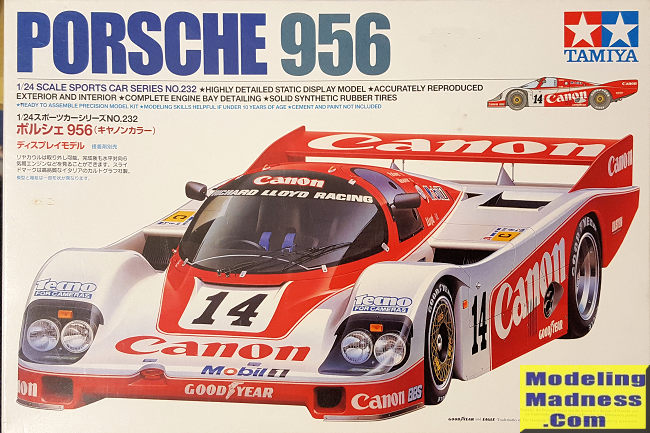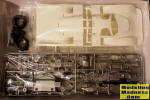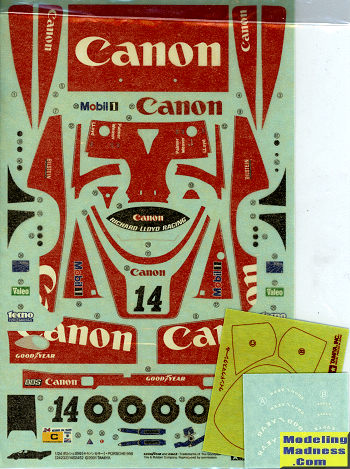
Tamiya 1/24 Porsche 956
| KIT #: | 24232 |
| PRICE: | 1600 yen SRP (I paid $20 plus shipping on the second hand market) |
| DECALS: | One option |
| REVIEWER: | Scott Van Aken |
| NOTES: | 2001 release |

| HISTORY |
The 956 made its debut at the Silverstone 6 Hour race, the second round of the World Championship for Makes with Jacky Ickx and Derek Bell driving for the factory. After missing the following round at the 1000 km Nürburgring for developmental reasons, the Ickx/Bell unit reappeared at the 24 Hours of Le Mans. They led the race for the entire 24 hours, eventually taking the overall win - their third win together. As they had already won in 1981 with a Porsche 936 that had used an early version of the 956 engine, their car had started number 1. The two other factory 956 followed them, so the three factory Porsches finished 1-2-3 in the order of their starting numbers.
Boosted by this success, Porsche sold customer versions of the 956 to privateer teams such as Joest Racing, Obermaier Racing, John Fitzpatrick Racing, Richard Lloyd Racing, Kremer Racing and Brun Motorsport who raced them independently of the factory.
The overall all-time lap record for the demanding 20 km Nürburgring-Nordschleife circuit in the Eifel Mountains was achieved during the qualifying session for the 1983 1000km of Nürburgring, by Stefan Bellof, who drove his 956 around in 6 minutes 11.13 seconds, at an average speed of 202 km/h (126 mph). The race lap record is held by the same Bellof, during the 1983 1000 km Nürburgring, the lap being clocked at 6:25.91.
At the 1985 1000 km of Spa, Bellof died after colliding with Jacky Ickx's newer 962. Safety concerns over the 956 led to its eventual end as teams upgraded to the safer 962. The 956's last win would come courtesy of Joest Racing in the last race of the 1986 WEC season, in what also turned out to be the 956's last race.
| THE KIT |
 Tamiya's
car kits are just as superbly molded and engineered as their armor and aircraft
kits. Like most non-US car model makers, Tamiya does the majority of their cars
to 1/24 scale, save for the F.1 cars which are to 1/20. Molded in a variety of
colors, the engine components are mostly grey, chassis bits mostly black and
body parts are white. There are clear windows, for which Tamiya provides paper
masks (these are sticky, you just have to cut them out), and vinyl tires. You
are also provided with decals for the tire logos.
Tamiya's
car kits are just as superbly molded and engineered as their armor and aircraft
kits. Like most non-US car model makers, Tamiya does the majority of their cars
to 1/24 scale, save for the F.1 cars which are to 1/20. Molded in a variety of
colors, the engine components are mostly grey, chassis bits mostly black and
body parts are white. There are clear windows, for which Tamiya provides paper
masks (these are sticky, you just have to cut them out), and vinyl tires. You
are also provided with decals for the tire logos.
These kits are not curbsides and come with a full engine and interior detailing. As with most of their kits, you really need to do a lot of pre-painting to get the proper effect. This often becomes a block to those used to American model cars where you don't have to do all that much, but the complexity of racing cars pretty much demands it. Once the engine and transmission are done, the rear suspension bits can be attached to it and then it can be attached to the rear of the floor pan.
 The interior
is well done and simple with decals being supplied for the seat harness and
instrument dials. The twin intercoolers attach to the back of the interior piece
and this assembly is then attached to the floor pan. Construction then moves to
the front suspension. All of the brake assemblies enclose polycaps so you can
simply plug in the wheels and tires near the end of the build. Decals are
supplied for the brake rotors which is another thoughtful touch.
The interior
is well done and simple with decals being supplied for the seat harness and
instrument dials. The twin intercoolers attach to the back of the interior piece
and this assembly is then attached to the floor pan. Construction then moves to
the front suspension. All of the brake assemblies enclose polycaps so you can
simply plug in the wheels and tires near the end of the build. Decals are
supplied for the brake rotors which is another thoughtful touch.
For the rest of the build, the bodywork is the major focus. Here you attach the instrument panel and steering wheel, lights, various clear bits and the wing. Once the front bodywork is glued to the chassis pan, the rear section can be slid into place, ready to be easily removed to show off the engine.
Instructions are well done and provide the usual Tamiya-only paint references. There is one set of markings for this boxing, and that is for the Canon sponsored car as run in the 1985 season by Richard Lloyd Racing. Decals are very nicely printed and if one uses hot water, they should work just fine. All of the red areas are provided as decals so one should be able to simply paint the body white and go from there. You can see in the image the paper window masks and the tire logo transfers.
| CONCLUSIONS |
You may be thinking to yourself 'I could never build anything that complex'. Well, yes you can. I've built several Tamiya and Fujimi racing car kits and while they take a bit of time and some planning, they went together quite well and the decals did just fine (if you use hot/very warm water). The end result is going to be a very colorful model.
| REFERENCES |
https://en.wikipedia.org/wiki/Porsche_956
February 2018
Copyright ModelingMadness.com. All rights reserved.
If you would like your product reviewed fairly and fairly quickly, please
contact
the editor or see other details in the
Note to
Contributors. Back to the Main Page
Back to the Review
Index Page
Back to the Previews Index Page